MIT course "Computer Systems Security". Lecture 19: "Anonymous Networks", part 3 (lecture from the creator of the Tor network)
Massachusetts Institute of Technology. Lecture course # 6.858. "Security of computer systems". Nikolai Zeldovich, James Mykens. year 2014
Computer Systems Security is a course on the development and implementation of secure computer systems. Lectures cover threat models, attacks that compromise security, and security methods based on the latest scientific work. Topics include operating system (OS) security, capabilities, information flow control, language security, network protocols, hardware protection and security in web applications.
Lecture 1: "Introduction: threat models" Part 1 / Part 2 / Part 3
Lecture 2: "Control of hacker attacks" Part 1 / Part 2 / Part 3
Lecture 3: "Buffer overflow: exploits and protection" Part 1 / Part 2 / Part 3
Lecture 4: "Separation of privileges" Part 1 / Part 2 / Part 3
Lecture 5: "Where Security Errors Come From" Part 1 / Part 2
Lecture 6: "Opportunities" Part 1 / Part 2 / Part 3
Lecture 7: "Sandbox Native Client" Part 1 / Part 2 / Part 3
Lecture 8: "Model of network security" Part 1 / Part 2 / Part 3
Lecture 9: "Web Application Security" Part 1 / Part 2 / Part 3
Lecture 10: "Symbolic execution" Part 1 / Part 2 / Part 3
Lecture 11: "Ur / Web programming language" Part 1 / Part 2 / Part 3
Lecture 12: "Network Security" Part 1 / Part 2 / Part 3
Lecture 13: "Network Protocols" Part 1 / Part 2 / Part 3
Lecture 14: "SSL and HTTPS" Part 1 / Part 2 / Part 3
Lecture 15: "Medical Software" Part 1 / Part 2 / Part 3
Lecture 16: "Attacks through the side channel" Part 1 / Part 2 / Part 3
Lecture 17: "User Authentication" Part 1 / Part 2 / Part 3
Lecture 18: "Private Internet browsing" Part 1 / Part 2 / Part 3
Lecture 19: "Anonymous Networks" Part 1 / Part 2 / Part 3
Suppose you use Bayesian probability, arguing in this way: “would the court have arranged the evidence that this guy was caught because of a bad OPSEC? Yes, they did. That is, I need reports that would say that he was caught due to non-compliance with the information security of operations on the Internet. ” Thus, for the “double construction” I would need reports that the guy got into a bad OPSEC, because evidence of this kind is quite accessible in a regular police investigation, without mentioning information obtained from intelligence.
')
We cannot draw conclusions about this case from any public reports, however, it seems that this guy was detained precisely because of non-compliance with the rules of OPSEC, that is, what you would have been looking for, trying to catch someone who is involved in illegal things. So, as I said earlier, do not use my network to violate any laws. In addition, if your life or liberty depends on using Tor or any other security product, do not use these products in isolation.

Consider creating multiple lines of defense if your life or freedom is at stake, or if a system crash is completely unacceptable for you. This is true for Tor, TLS, and PGP. Software is an unfinished job.
That's all I wanted to say about online abuse. I have 25 minutes left for hidden services.
Anonymity of the respondent is a much more complex problem than the anonymity of the initiator. The anonymity of the initiator is what you get when Alice wants to buy socks, but at the same time remains anonymous for the seller of socks.
Respondent's anonymity is when Alice wants to publish her poems on the Internet and run a web server with her poetry, but does not want anyone to find out where this web server is located, because poetry is so embarrassing. So yes, in fact, there is a hidden service with my bad poems. No, I do not think anyone has already published them. No, I'm not going to tell anyone where he is. I'm just waiting for it to become public.
Suppose Alice wants to publish her poems. I will put it on the right, because she is the respondent. Alice can pave the way - this spiral line depicts several repeaters - to the Tor network, this R, and ask him: “please accept these connections!”. So now anyone who connects to this repeater can say they want to talk to Alice. There were projects that worked that way.
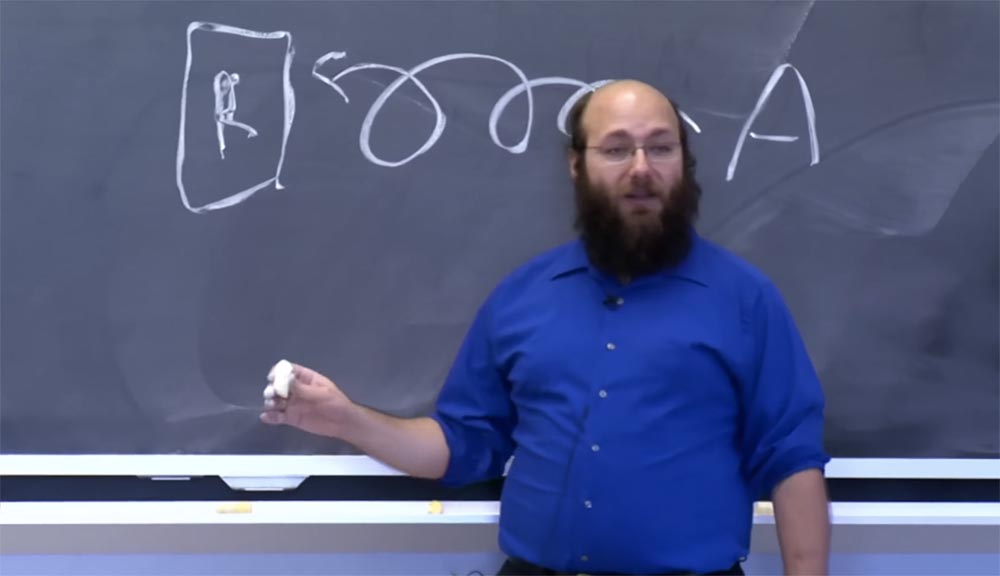
However, there are some problems. One problem is that this relay can be a “man in the middle”, which intercepts all traffic if there is no well-known TLS key here. The second problem may be that the person who owns this verse and who is also ashamed of his poems and does not want to be a public distributor of poetry, owns this repeater, because it is so terrible!
It can also be affected by other people who own a transponder R, who hate poetry so much that they want to subject this connection to their censorship. Finally, this R transponder can simply be the target of an attack.
Therefore, you would like Alice to switch between different repeaters all the time, and none of them could affect her unencrypted traffic. This is quite doable.
But if we have a lot of different transponders, what does Alice have to say to people? There should be something like a public key here, because if it just accesses the network: “repeater X, repeater Y, repeater Z”, this will not work because the network changes every 5 minutes and getting the correct, working repeater is difficult .
Suppose she informs all members of the network with a public key, and when she comes here, to R, she says: “this is Alice, I will prove it with my public key”. Thus, R knows that the PKz public key runs a particular hidden service — Alice’s poetry. Therefore, if someone else says, "Hey, connect me with the public key Z", then you can make a handshake with Alice with the help of a shared key. And this is the same handshake that is used in the Tor chain.
Now Bob will be able to read Alice’s verses, making another connection through the Tor network. Knowing the PKz key, Bob will be able to tell the transponder: "Hey, connect me with Alice with this PKz." After the repeater performs a handshake together, Bob and Alice will have a shared key, which they can use to encrypt throughout the connection.
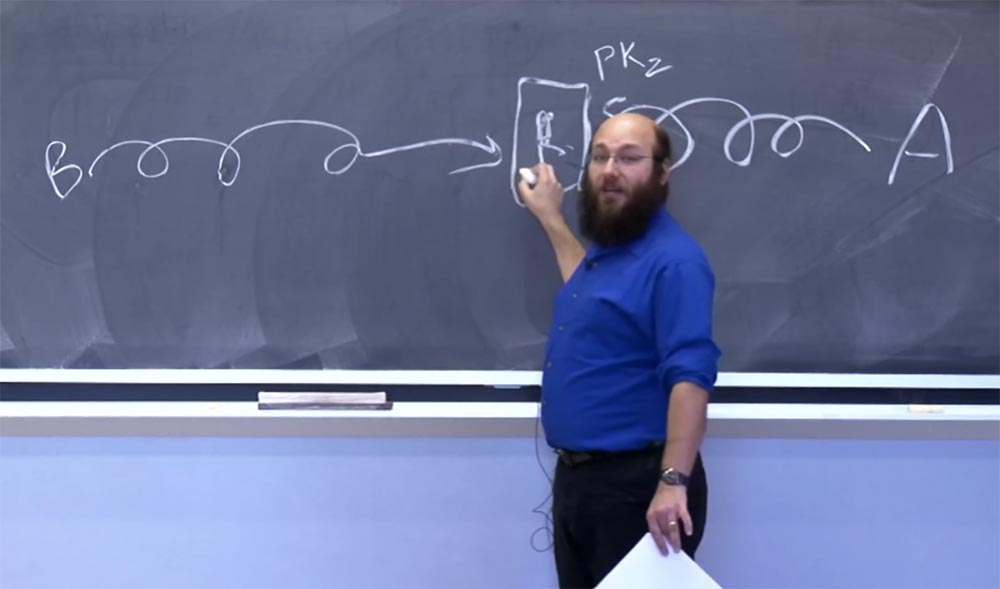
There is something that I missed, namely, how do Bob know how to get here? How does this repeater recognize the PKz public key? We can add to the system a certain directory system where Alice anonymously via Tor uploads a signed application stating that PKz is on X relay. In this case, Bob asks the directory system to give him this signed statement about PKz, through which Bob finds out where he needs go. We could do even better — let Alice supply another public key, let's call it PKw, and the statement she uploads to the directory and which says that if you want to talk to the public key service Z, then you should go to the Rx repeater. using the public key W.

In this case, the public key Z is not published on the Rx transponder. You could go ahead and encrypt the expression (Rx, PKw) with some shared secret known to Alice and Bob. If you do this, the directory service and people who can contact the directory service will not know how to connect to Alice using this PKz key.
Student: if it is not encrypted, then the Rx relay can find out that it is running the service for Alice, right?
Nick Mathewson: No, not for Alice. He can only find out what the PKz key is using if this expression is not encrypted. We have a solution how to create such a system, it has not been built yet, but it will be cool.
Suppose you do not want to use a centralized directory for this. In this case, we actually use DHT, which is not perfect and subject to censorship, but we are trying to make it possible to use censorship less and less. I could tell you more about this, but I’m afraid I don’t have time to cover the remaining topics.
There is another problem: if you use one of these service directories and you have a complete list of keys, then you can connect to all those who have not encrypted their connections to find out what they have there. This is called an enumeration attack, or “enumeration attack”. We did not mention this in our newspaper, not because we do not care, but because we are not yet ready to withstand such attacks.
I hope that in 2014 we will find a solution in which Alice and Bob share the key PKz, but this expression (Rx, PKw) is not signed with the key PKz. It is signed by PKz 1 , which is derived from PKz, and, say, the date:
PKz 1 → PKz, Date
If you know PKz and the date, you can get PKz 1 . If as Alice you know the secret of SKz, you can create messages that are signed by PKz 1 .
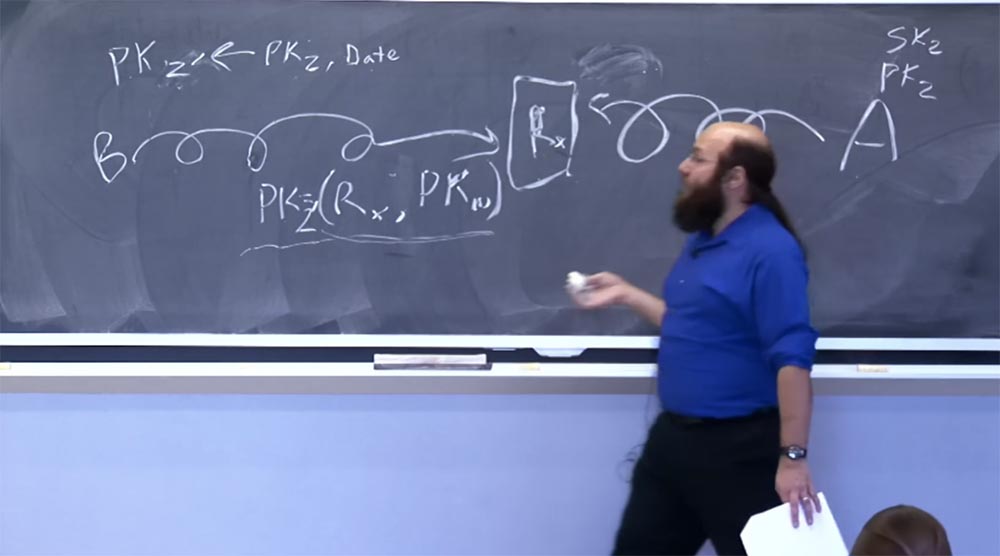
But if you only see PKz 1 , then even knowing the date, you cannot re-receive PKz. We have evidence of the possibility of this decision, and if you want to know how it works, then write to me and I will send them to you. This is a cool trick. We are not the first to come up with this idea. But this is the way in which we are going to solve the problem of enumeration attack in the current year, if I really find time to put this solution into practice. That's all for hidden services.
Consider the issue of attacks and defense. Until now, the largest category of attacks that we have seen is attacks at the application level. If you launch an application through Tor, and it sends unencrypted traffic as a normal HTTP connection, then the hostile exit point node, like any other node that allows HTTP connections, can monitor and modify this traffic. This is attack number 1 in our system. You can resist it using encrypted traffic.
Fortunately, over the past few years, encryption is on the rise, and more and more traffic is being encrypted by an excellent free certificate authority, which EFF, Mozilla and Cisco reported a day or two ago. I hope that in 2015 the unencrypted traffic will be even less than it was this year. So this approach solves this problem.
More interesting attacks include things like traffic tagging, or traffic marking. We made a mistake in our previous implementation of the integrity check. Our early implementation of the integrity check ended with an integrity check between the Alice program and the exit point node, but it turned out that this was not enough. Because if the first R1 repeater "confuses" the traffic in such a way that it creates a pattern that can detect the exit point node, then for the first and the last repeater it will serve as a way to find out that they are on the same common path, in the same chain, and identify Alice
Of course, if the first and the last repeater cooperate in one way or another, then in any case they will be able to determine Alice by comparing traffic, but we hope that this will not be easy for them and over time the process of correlating traffic will become harder than we think.
In fact, it would be good to end this type of attack once and for all. For this we have two solutions. One of the expected results of such attacks is to periodically break the chains, because the attacker on the first hub made a mistake regarding control over the last hub.
Therefore, every Tor client checks for a strange bounce rate. An effective long-term solution to the problem is to ensure that “fussing” with the template on the first hub does not create more than 1 bit of information on the last hub. You cannot avoid sending 1 bit of information, because the first hub can always simply disconnect the connection, but you can limit this information to the value of 1 bit. Or better to 2 bits, because then they will have the choice to damage the data or disconnect the connection. I had an idea how best to do this, so I’ll think about this problem.
Denial of service, or DOS, is also important. Last year there was an article about what the authors called the "sniper attack." You see traffic coming from a Tor node that you do not control, and therefore you want to drive everyone away from that node. To do this, you connect to this node, overflow all the buffers of its memory, and it “falls”. After that, you redirect the traffic you are interested in to the node you control, and if it hits the uncontrolled node, then repeat this technique several times until the desired result is achieved.
Our best solutions are designed to eliminate the possibility of a DOS attack on the memory, and our patches have virtually eliminated this possibility. Another option for solving problems of this kind is to make sure that the repeater has a large memory capacity. Therefore, do not use low capacity repeaters on the network. We also do this - if you try to start the Tor node on your phone, it will not receive authorization and will not be included in the list of trusted nodes.
We are also trying to develop chain planning algorithms, although it is very difficult to try to develop a network diagram of nodes that you do not control, so for now this is an unsolved problem.
Now tell me, is it better to tell you about interesting attacks or important attacks?
Student: about interesting!
Nick Mathewson: good. Then let those who would like to write a program that uses cryptography raise their hands? Great, this is what you should learn! But never trust the implementation of your cryptography. Even if it’s right, it’s still wrong. A long time ago we had one of the worst security mistakes. We considered that each repeater could be a “man in the middle” in any chain of nodes, because we assumed that the correct implementation of the Diffie-Hellman algorithm would check whether 0 passed as one of the inputs.
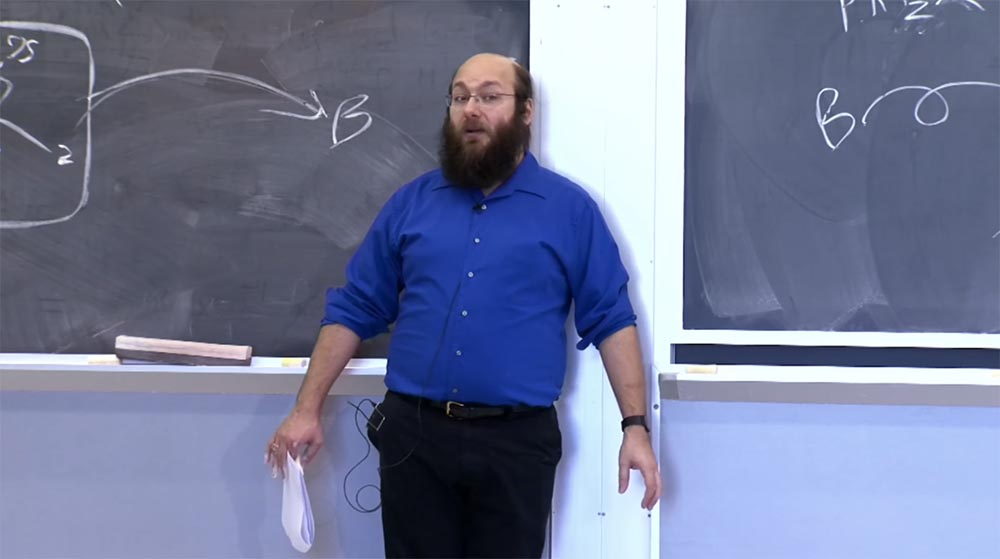
The authors of our Diffie-Hellman implementation assumed that the proper application would never pass on a Diffie-Hellman implementation zero.
How does the correct Diffie-Hellman algorithm work? Suppose I have g x and you have g y . I know X, you know Y, and we both can calculate g xy . But if instead “man in the middle” replaces my g value with zero, then I calculate 0 x , you calculate 0 y , we will have the same key, and we can easily communicate with each other, but this will be the key that the attacker knows, what is it 0.
The unit works, P also works, P + 1 also works. Thus, you just need to make sure that your g x and g y values are in the range from 2 to P-1, if you implement the Diffie-Hellman algorithm in the form of z sub p.
I would like to talk more about censorship. After all, in fact this is one of the areas where we can do the most good. In the beginning, we thought to make Tor look like a web client talking to a web server over HTTPS and make it hard to block. It turns out that it is fantastically difficult and probably not worth doing.
Now we are using an approach that uses various plug-ins that allow using unaccounted repeaters as a bridge, and the user can use this scheme for various traffic conversions. We manage to make it so that new repeaters are added to the network faster than censors implement their blocking.

In fact, this is the case when none of the solutions is categorically workable. Probably, I did not formulate my idea in this way. It would be more correct to say that none of these plug-ins are essentially nonblocking by any modern technology, but they are good enough to keep traffic unblocked for 1-2 years in most countries or 6-7 months in China.
China currently has the most competent censors in the world, largely because it does not use outsourcing. Most other countries with aggressive censorship of the Internet transfer the functions of censors to European, American and Asian companies, whose interests are not really to sell effective software for censoring the Internet, but to force their customers to constantly participate in the race to update it.
For example, you can buy your censorship software in the United States. Technically speaking, US companies do not have the right to make censorship programs for third countries, but the US has developed a corporate firewall that scales up to 10 million users. I think this is unethical, but again, I am not a member of political organizations or a philosopher.
Paul Cyverson, one of the authors of Tor, has a degree in philosophy, but even he cannot answer these questions. But he spends a lot of time not to answer them.
So what did I stop at? 90 minutes is a long time. On censored! So, Tor has repeatedly circumvented the censorship of various developers. They try to block the latest versions of Tor, but at the same time make a rather weak lock. Therefore, if we change 1 bit somewhere in the same node identifier, we can easily bypass such a lock.
We cannot prove that they deliberately make Tor bypass the blocking, that is, they sell blocking programs that do not work and then sell one update after another for them. But it seems to us that it is so. – , , .
, , , . , , . , «» – , , .
, – . Tor — , . , , . freehaven.net/anonbib/ , .
I2P, Gnunet, Freedom — «», , , Mixmaster, Mixminion, Sphynx Y, Sphinx I – - , DC-net, DC-net . , . , Tor — , , .
— . , — , , , , — , , . . , . , , , , , . , : « , ». , 10 , .

, Tor. , :
PKz 1 → PKz, Date
, , . , , .
. 2003 RSA-1024, . RSA-1024 Ed25519. , , .
path selection, . 5-6 , . .
, - . , , , , - . , - - , 2015 . - – , !
, . , . . 10 20 . , , , 100 , - .
, , , . — , .
, , 100 – - . , , , - .
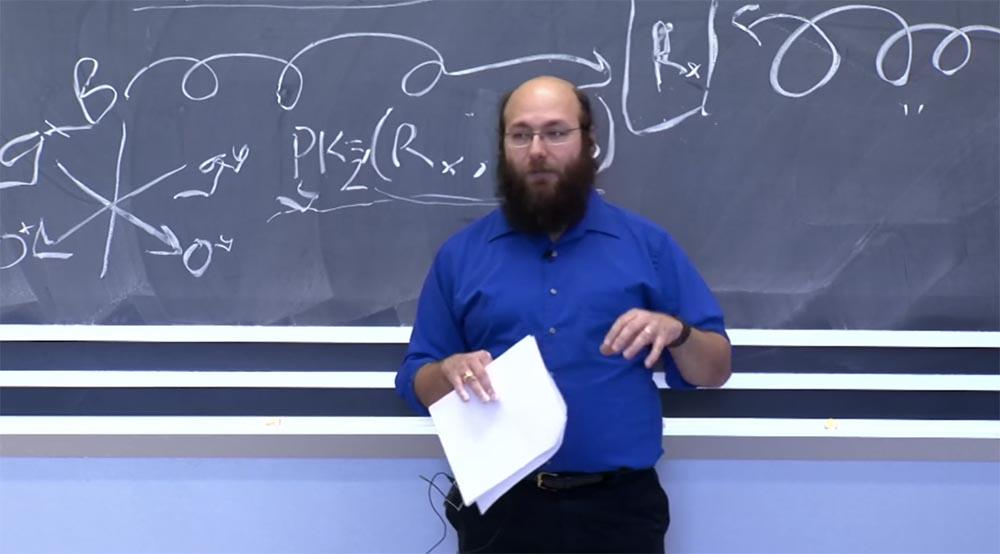
- , . , , , , .
, , .
- , , - , . : «, , !». , 2 , 6. , , , - .
, , , . «», , - , . , , , - .
, . ? Not? , . , . , 12:25, . . , , !
.
Thank you for staying with us. Do you like our articles? Want to see more interesting materials? Support us by placing an order or recommending to friends, 30% discount for Habr users on a unique analogue of the entry-level servers that we invented for you: The whole truth about VPS (KVM) E5-2650 v4 (6 Cores) 10GB DDR4 240GB SSD 1Gbps from $ 20 or how to share the server? (Options are available with RAID1 and RAID10, up to 24 cores and up to 40GB DDR4).
VPS (KVM) E5-2650 v4 (6 Cores) 10GB DDR4 240GB SSD 1Gbps until January free of charge if you pay for a period of six months, you can order here .
Dell R730xd 2 times cheaper? Only we have 2 x Intel Dodeca-Core Xeon E5-2650v4 128GB DDR4 6x480GB SSD 1Gbps 100 TV from $ 249 in the Netherlands and the USA! Read about How to build an infrastructure building. class c using servers Dell R730xd E5-2650 v4 worth 9000 euros for a penny?
Source: https://habr.com/ru/post/431266/
All Articles